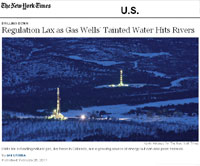|
Urge Governor Cuomo to Extend Executive Order No. 41
The ground-breaking New York Times series by Ian Urbina, documents an extensive and disturbing amount of information that was gathered from EPA, state regulators and gas drilling companies, not previously made available, either to the public or to key government regulators and decision-makers. The EPA memo reveals that Pittsburgh residents suffered “one of the largest failures in US history to supply clean drinking water” due in part to fracking wastes.
According to the Times, the drilling industry has also hidden the conclusions reached by its own studies, while publicly taking the position that the radioactive elements in drilling waste are not a concern, including a confidential industry study that agreed with EPA’s conclusion that radioactivity in drilling waste cannot be fully diluted by discharging it into rivers and other waterways. Another study in l990 found that radium in drilling wastewater dumped in the Louisiana coast posed “potentially significant risks” of cancer for people who regularly eat fish from those waters.
Nevertheless, the second Times article in the series reported that millions of gallons of drilling wastewater are treated at plants that continue to discharge their treated waste into rivers. Despite the potential health and environmental hazards associated with radioactive wastewater, federal regulators recently confirmed to the gas industry that drilling waste remains exempt from federal hazardous waste law.
The third article in the series reveals that a deeply divided EPA has failed to increase needed regulation of oil and gas drillers and to enforce existing federal pollution laws that some agency lawyers insist are clearly being violated. As an EPA lawyer explained in an internal memo obtained by the Times, “Treatment plants are not allowed under federal law to process mystery liquids . . . . Mystery liquids is exactly what this drilling waste is.”
The proposed Delaware River Basin Commission (DRBC) regulations and the New York State Department of Environmental Conservation’s (DEC) current draft supplemental generic environmental impact statement both are fundamentally flawed. Also, there are nowhere near enough regulators to assure that even a sound permitting regime could be administered effectively, especially given the drilling industry’s consistent disregard for human health and the environment. Without major shifts in approach by regulators and industry, far more resources and a much longer timeframe than DEC and DRBC officials currently are working under, we can’t see how this can be fixed.
We are asking you to take action now to maximize the positive momentum the NY Times stories have generated. Urge Governor Cuomo to extend Executive Order No. 41 for at least a year beyond July 1, 2011 to afford DEC the time necessary to update the 1992 GEIS on a comprehensive basis, incorporating a cumulative impact analysis, and to take steps to ensure that DEC has the staff and budget necessary to complete the SEQRA process and to do a formal rule-making after that process is complete.

|
View as webpage


| If you received this from a friend, sign-up to receive alerts in your in-box! |
Support our Watershed

|